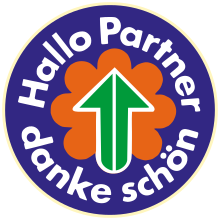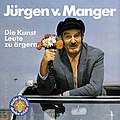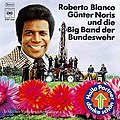Hello partner - thank you

"Hello partner - thank you" was the title of the first nationwide campaign by the German Road Safety Council, founded in 1969 . It was unveiled to the public on October 4, 1971. In view of the increasing number of accidents and many road deaths, the “hello partner” slogan with positive models should promote consideration and helpfulness in road traffic and bring about a “climate change in traffic” - according to the motto of the campaign. The campaign ran from 1971 to 1974. The motto and logo were also used later. The campaign logo has been registered as a German word and image trademark since June 30, 2016 .
Records
As part of the campaign, two singles with prominent artists were produced, of which a total of 120,000 pieces were distributed. American pop and hit singer Peggy March , who also appeared at the official launch of the campaign on October 4, 1971, sang the title song “Hallo Partner - danke schön” in 1971 on the A side of the single “Climate Change in traffic ”appeared. The B-side contained the title "Partner in Traffic - The Art of Annoying People" by Jürgen von Manger .
In 1972 a second record followed with Roberto Blanco and the Bundeswehr Big Band with Günter Noris on the A-side with a new version of the "Hello Partner" song. On the B-side was the title "The modern tax reform" from the cabaret " The Porcupines ".
After the official end of the campaign, a single by the band Truck Stop was released in 1982 with the two titles "Die Frau mit dem Gurt" (A-side) and "Ich pfeife auf die Autobahn" (B-side), jointly by the administrative trade association and the German Road Safety Council.
As a rule, bumper stickers with the campaign logo were also distributed with the sound carriers.
"Hallo Partner" record by Peggy March (1971)
Jürgen von Manger : "The Art of Annoying People" (1971)
Roberto Blanco with the Bundeswehr Big Band (1972)
Poster campaigns
During the campaign there were numerous poster campaigns on motorways, federal highways and factory car parks. Since around 900,000 posters were distributed over the course of the campaign, the various motifs were an integral part of the public space for several years. A series of posters was printed with "experts" slogans, which gave road users recommendations on how to behave safely in traffic:
- 1971: "The experts let go"
- 1972: "Experts are partners"
- 1972: "Experts wear a belt"
- 1973: "Experts keep their distance"
- 1973: "Experts take breaks"
- 1974: "Experts drive attentively"
Individual posters were dedicated to specific topics:
- 1971: "Climate change in traffic"
- 1971: "Distance - half the speedometer"
- 1974: "Children always in the back"
Media work
In 1973, programs for different target groups were broadcast on public television. In the children's program “Der Kreisel” the hedgehog explained to Smurf safe behavior in traffic. In the traffic safety program “Herr Daniel attends ” (directed by Alfred Noell ), which André Roche animated in 1973 for the Cineplast studio, figures in clay animation showed safe behavior in traffic.
An adult audience was addressed with the WDR television quiz "1 + 1 against 2" in six episodes with the moderator Werner Zimmer . In 1973 or 1974, a major event with the motto "With belt and without flag" with moderator Frank Elstner took place in the crown building of the Krone Circus in Munich, and ten million viewers saw it live on ARD and ZDF .
In addition to the television productions, audio shows were designed on various topics such as "Road safety on the way to work", which were aimed at the police and vocational schools, among others.
In newspaper advertisements, celebrities such as Hanns Joachim Friedrichs , Günter Kilian , Rudi Arndt , Ernst Stankowski and Cindy & Bert acknowledged the goals of the campaign.
Range and Effects
Even if it was not yet customary in the 1970s to scientifically monitor such campaigns in order to measure their effect, the media reach was repeatedly checked with surveys. In the first year of the campaign, 134 million reader contacts were reached through our own press templates and a further 249 million through external press reports. As early as the spring of 1972 - six months after the start of the campaign - 52% of German citizens already knew the motto "Hello partner - thank you". In 1973 the level of awareness had increased to 71%. Also in the spring of 1972, a survey showed that improving road safety was more important to the population than in previous years. The respondents ranked road safety as the second most important reform project of the state after the fight against crime. In a further survey in 1972, 72% of those questioned asked politicians to do more to ensure road safety.
In 1973 the medical-psychological institute of TÜV Rheinland conducted a survey among 500 car drivers on behalf of the DVR . 78% of them described a campaign such as “Hello partner - thank you” as necessary, only 3% as superfluous. In a representative survey in the last year of the campaign (1974), carried out by Infratest with 2020 road users, three quarters of the respondents expected the campaign to benefit their own safety and 9 out of 10 expressed the expectation that partnership behavior would reduce the number of accidents could significantly reduce. A third had the impression that behavior in road traffic had noticeably improved since the beginning of the campaign, including 41% car drivers and 27% cyclists and pedestrians.

View or edit raw data
The number of fatalities and injuries fell between 1970 and 1974 by 24% from 19,193 to 14,614, just as significantly as the number of injuries, which fell by 15% from 164,000 to 139,000. To what extent this can be attributed to the campaign has not been researched. In view of important changes in traffic law during the same period, such as the restriction of the maximum speed on country roads to 100 km / h (1972) and the introduction of the 0.8 alcohol limit (1973), as well as the first oil price crisis in 1973, other significant factors influencing the Decrease in the number of deaths and injuries in road traffic.
course
The following table gives the approximate chronology of the campaign:
- 1971: Logo and sticker "Hello partner - thank you"
- 1971: Slogan "Let the experts go"
- 1971: Slogan "Climate change in traffic"
- 1971: "Hello partner song", Peggy March
- 1971: “The art of annoying people”, cabaret artist Jürgen von Manger
- 1971–1974: Sticker "You drive the best by far"
- 1971: Motorway poster "Distance - half the speedometer"
- 1972: Slogan "Experts are partners"
- 1972: Slogan "Experts wear a belt"
- 1972: DVR audio show on the subject of commuting dvr-medienarchiv.de
- 1972: "Hello partner - thank you", Roberto Blanco , Big Band of the Bundeswehr under the direction of Günter Noris with the new version of the Hello Partner song dvr-medienarchiv.de
- 1972: “The modern tax reform”, The Porcupines dvr-medienarchiv.de
- 1973: Slogan "experts keep their distance"
- 1973: Testimonials from Ernst Stankowski , Günter Kilian , Hanns Joachim Friedrichs , Rudi Arndt , Cindy & Bert
- 1973: Children's program “Der Kreisel” dvr-medienarchiv.de
- 1973: Traffic safety program "Mr. Daniel is watching " dvr-medienarchiv.de
- 1973: WDR television quiz "1 + 1 against 2" host Werner Zimmer, six episodes dvr-medienarchiv.de
- 1973: Slogan "Experts take breaks"
- 1973: Event in the circus Krone Bau Munich "With belt and without flag" dvr-medienarchiv.de
- 1974: Slogan "Experts drive attentively"
- 1974: Slogan "Children always in the back"
- 1976: Brochure "Thank you partner - great" from the follow-up campaign from 1976
Follow-up campaigns
The campaign had a defined start date of October 4, 1971, but no clear end point. Due to the great success, annual follow-up campaigns were designed for a more targeted reaction to current developments, which made use of the uniform “Hello Partner” logo. This resulted in several interrelated, but clearly independent, annual campaigns. In 1975 the campaign was called: “Thank you partner - the direction is right”, 1976 “Thank you partner - great”, 1977 “Point by point more partnership”, 1978 “Partner 78: Active for more security” and 1979/1980 “More partnership - more Safety". In addition, in the years after 1971 there were repeatedly high-profile projects, for example 1974/1975 "Click - first strap, then start", which also had the "Hello partner" motto.
Web links
- Media for the “Hello Partner” campaign in the DVR media archive
Individual evidence
- ↑ a b c d e f g h German Road Safety Council e. V. (DVR) (Ed.): DVR-report . Road safety magazine. tape 39 , no. 2 , 2009, p. 9-10 ( germanroadsafety.com [PDF]).
- ↑ S. Werber: Incentive systems in road safety marketing - illustrated using practical examples . In: Fritz Meyer-Gramcko (Hrsg.): Driver assistance systems: Questions to psychology from the point of view of the motor vehicle engineer (= Deutscher Psychologen Verlag GmbH [Hrsg.]: 37th BDP Congress for Traffic Psychology ). 1997, ISBN 3-931589-31-5 .
- ↑ “Hello partner - thank you” campaign started. In: chroniknet. Josef Höckner, accessed on September 2, 2020 .
- ↑ Word-figurative mark DE302016018723: Hello partner, thank you. Registered June 30, 2016, published September 22, 2016, applicant: Deutscher Verkehrssicherheitsrat e. V., 53229 Bonn, Depatisnet
- ↑ Peggy March, "Hello partner - thank you" and Jürgen von Manger "Partner in traffic - The art of annoying people" at Discogs
- ↑ Roberto Blanco, Günter Noris And The Big Band Der Bundeswehr / Die Stachelschweine - Hello Partner Thank You At Discogs
- ↑ Truck Stop - The woman with the belt at Discogs
- ↑ Children's program on road safety “Der Kreisel” (ZDF). The hedgehog "Smurf" shows how to behave properly in traffic. German Road Safety Council , 1973, accessed on September 23, 2020 .
- ↑ Children's program on road safety "Mr. Daniel is watching". German Road Safety Council , 1973, accessed on September 23, 2020 .
- ↑ TV quiz "1 + 1 against 2" (WDR). German Road Safety Council , 1973, accessed on September 23, 2020 .
- ↑ "With belt and without flag": date of the source of the photograph
- ↑ Kai Posmik: Buckle up please! - Introduction of seat belts . In: Spiegel-Verlag Rudolf Augstein (Ed.): Der Spiegel . December 23, 2010 ( spiegel.de ).
- ↑ DVR audio show on the subject of commuting. In: Digital media archive. German Road Safety Council e. V., 1972, accessed on September 23, 2020 .
- ↑ a b campaign “I confess to climate change in traffic”. In: DVR media archive. German Road Safety Council , 1973, accessed September 24, 2020 .
- ↑ a b c d Note on the talk page for this article
- ↑ Press release No. 265 of July 14, 2020 on the number of road deaths in Germany. In: destatis.de. Federal Statistical Office (DESTATIS), Wiesbaden, July 14, 2020, accessed on September 24, 2020 .
- ↑ Logo "Hello partner - thank you". In: Digital media archive of the German Road Safety Council . 1971, accessed September 2, 2020 .
- ↑ a b c d e f g h i j k l m n o p digital media archive of the German Road Safety Council. Retrieved September 2, 2020 .
- ^ Poster "Climate change in traffic". In: Digital media archive of the German Road Safety Council . 1971, accessed September 2, 2020 .
- ↑ Peggy March's record with the “Hello Partner Song”. In: Digital media archive of the German Road Safety Council . 1971, accessed September 2, 2020 .
- ↑ Record "The Art of Annoying People", cabaret artist Jürgen von Manger. In: Digital media archive of the German Road Safety Council . 1971, accessed September 2, 2020 .
- ↑ Poster "Experts keep their distance". In: Digital media archive of the German Road Safety Council . 1973, accessed September 2, 2020 .
- ↑ Brochure “Thank you partner - great”. In: DVR media archive. German Road Safety Council e. V., 1976, accessed September 24, 2020 .








